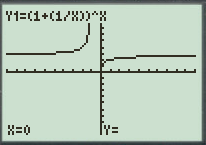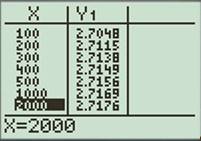
Concept explainers
(a)
To find: The domain of the function
(a)
Answer to Problem 60E
The domain of the function
Explanation of Solution
Given information: The function is
Calculation:
The function
Simplify the expression.
This is possible only if
Therefore, the domain of the function
(b)
To graph: The function
(b)
Explanation of Solution
Given information: The function is
Graph:
To graph a function
First press “ON” button on graphical calculator, press
The display will show the equation,
Now, press the

Figure (1)
Interpretation: From the graph it can be observed that the function is continuous at every point in its domain except
(c)
To explain: The reason for discontinuity of
(c)
Answer to Problem 60E
The function
Explanation of Solution
Given information: The function is
Calculation:
As observed from the graph in part (b), the function
As observed from the graph in part (b), the value of function
The value of
Therefore, the function
(d)
To find: The point of removable discontinuity of
(d)
Answer to Problem 60E
The point of removable discontinuity of
Explanation of Solution
Given information: The function is
Calculation:
As observed from the graph in part (b), the function
So, the point
Therefore, the point of removable discontinuity of
(e)
To find: The value of
(e)
Answer to Problem 60E
The value of
Explanation of Solution
Given information: The function is
Calculation:
As observed from the graph in part (b), the function
Now check the limit by table.
To make the table of function
First press “ON” button on graphical calculator, press
First set the table setup, enter the keystrokes
Now draw the table, enter the keystrokes

Figure (2)
As observed from table the value of
Therefore, the value of
Chapter 2 Solutions
Calculus 2012 Student Edition (by Finney/Demana/Waits/Kennedy)
Additional Math Textbook Solutions
Calculus: Early Transcendentals (3rd Edition)
Calculus and Its Applications (11th Edition)
Thomas' Calculus: Early Transcendentals (14th Edition)
Precalculus Enhanced with Graphing Utilities (7th Edition)
Precalculus: Concepts Through Functions, A Unit Circle Approach to Trigonometry (4th Edition)
Single Variable Calculus: Early Transcendentals (2nd Edition) - Standalone book
 Calculus: Early TranscendentalsCalculusISBN:9781285741550Author:James StewartPublisher:Cengage Learning
Calculus: Early TranscendentalsCalculusISBN:9781285741550Author:James StewartPublisher:Cengage Learning Thomas' Calculus (14th Edition)CalculusISBN:9780134438986Author:Joel R. Hass, Christopher E. Heil, Maurice D. WeirPublisher:PEARSON
Thomas' Calculus (14th Edition)CalculusISBN:9780134438986Author:Joel R. Hass, Christopher E. Heil, Maurice D. WeirPublisher:PEARSON Calculus: Early Transcendentals (3rd Edition)CalculusISBN:9780134763644Author:William L. Briggs, Lyle Cochran, Bernard Gillett, Eric SchulzPublisher:PEARSON
Calculus: Early Transcendentals (3rd Edition)CalculusISBN:9780134763644Author:William L. Briggs, Lyle Cochran, Bernard Gillett, Eric SchulzPublisher:PEARSON Calculus: Early TranscendentalsCalculusISBN:9781319050740Author:Jon Rogawski, Colin Adams, Robert FranzosaPublisher:W. H. Freeman
Calculus: Early TranscendentalsCalculusISBN:9781319050740Author:Jon Rogawski, Colin Adams, Robert FranzosaPublisher:W. H. Freeman
 Calculus: Early Transcendental FunctionsCalculusISBN:9781337552516Author:Ron Larson, Bruce H. EdwardsPublisher:Cengage Learning
Calculus: Early Transcendental FunctionsCalculusISBN:9781337552516Author:Ron Larson, Bruce H. EdwardsPublisher:Cengage Learning





